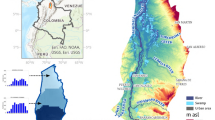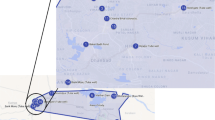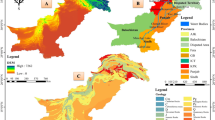Abstract
Using gamma ray spectroscopy with high purity germanium detector, the activity concentrations of 238U, 232Th and 40K radionuclides in drinking water samples from two areas in Bordj-Bouarreridj, east of Algeria were measured. The mass concentrations were found to range 10.46–63.56 µg/L for 238U, not determined value to 9.83 µg/L for 232Th and 5.29–6.80 µg/L for 40K. The chemical and physical characteristics of the drinking water samples were determined. The human radiological risk was calculated on the lifetime consumption of the population of the studied area based on the results obtained.


Similar content being viewed by others
References
Hazzaba A (2011) Eaux minérales naturelles et eaux de sources en Algérie Natural mineral waters and spring waters in Algeria. C. R. Geosci 343:20–31. https://doi.org/10.1016/j.crte.2010.11.007
Décret n° 95–159 du 15 Janvier 1994, relatif aux prérogatives de l’Office National des Statistiques, Journal officiel de la république algérienne, 1994
Nguelem EJM, Darko EO, Ndontchueng MM, Schandorf C, Akiti TT, Muhulo AP, Dogbey ROG (2013) Assessment of natural radioactivity level in groundwater from selected areas in accra metropolis. Res J Environ Earth Sci 5:85–93. https://doi.org/10.19026/rjees.5.5642
Calin MR, Ion AC, Radulescu I (2014) Evaluation of quality parameters and of natural radionuclides concentrations in natural mineral water in Romania. J Radioanal Nucl Chem 303:305–313. https://doi.org/10.1007/s10967-014-3401-x
Kitto ME, Kim MS (2005) Naturally occurring radionuclides in community water supplies of New York State. Health Phys 88:253–260. https://doi.org/10.1097/01.hp.0000149879.58455.1f
Kim YS, Park HS, Kim JY, Park SK, Cho BW, Sung H, Shin DC (2004) Health risk assessment for uranium in Korean groundwater. J Environ Radioact 77:77–85. https://doi.org/10.1016/j.jenvrad.2004.03.001
WHO (2003) World Health Organization Guidelines for drinking water quality, 2nd edn. Total dissolved solids in Drinking-water, Geneva, 1996.
Narasimha Prasad NB (2010) Groundwater resource evaluation and management. ResearchGate Technical Report January 2010
Hamil L, FG Bell (1986) Groundwater resource development. Chapiter 5: Groundwater quality. pages 119–147. ISBN 0-408-01409-1
Kebir H, Boucenna A (2017) Natural radionuclide concentrations in thermal springs of east Algeria. Environ Earth Sci 76:52. https://doi.org/10.1007/s12665-016-6373-z
ICRP (1996) International Commission on Radiological Protection Age-dependent Doses to the Members of the Public from Intake of Radionuclides, Part 5. Compilation of Ingestion and Inhalation Coefficients, New York
EPA (2002) United States Environmental Protection Agency Guidelines for Ensuring and Maximizing the Quality, Objectivity, Utility and Integrity, of Information Disseminated by the Environmental Protection Agency. EPA260-R-02-008
WHO (2008) World Health Organization Guidelines for drinking water quality, 3rd edn. Incorporating the First and second Addenda, Geneva
WHO (1993) World Health Organization Guidelines for drinking water quality: volume1: Recommendations, 2nd edn. Geneva
USEPA (1994) United States Environmental Protection Agency Comparison of Health Risks Arising From the Radiological and Chemical Toxicity of Uranium, Appendix F of Radiation Site Cleanup Regulations: Technical Support Document For The Development Of Radionuclide Cleanup Levels For Soil, Review Draft, EPA 402-R-96-011 A.
USEPA (2003) United States Environmental Protection Agency Current Drinking Water Standards Agency
WHO (2009) World Health Organization Guidelines for drinking water quality. Potassium in drinking-water Background document for development of WHO Guidelines for Drinking-water Quality, Geneva
WHO (2007) World Health Organization Guidelines for drinking water quality. pH in Drinking-water, Revised background document for development of WHO Guidelines for Drinking-water Quality
Abd El-Mageed AI, EL-Kamel AH, Abbady AB, Harb S, Issa Saleh I (2013) Natural radioactivity of ground and hot spring water in some areas in Yemen. Desalination 321:28–31. https://doi.org/10.1016/j.desal.2011.11.022
Labidi S, Dochraoui M, Mahjoubi H, Lemaitre N, Ben Salah R, Mtimet S (2002) Natural radioactive nuclides in some Tunisian thermo-mineral springs. J Environ Radioact 62:87–96. https://doi.org/10.1016/S0265-931X(01)00153-9
Oliveira J, Moreira SRD, Mazzilli BP (1994) Natural radioactivity in mineral spring waters of a highly radioactive region of Brazil and consequent population doses. Radiat Prot Dosim 55:57–59. https://doi.org/10.1093/oxfordjournals.rpd.a082375
Joksic JD, Radenkovic MB, Miljanic SS (2007) Natural radioactivity of some spring and bottled mineral waters from several central Balkan sites, as a way of their characterization. J Serb Chem Soc 72:621–628. https://doi.org/10.2298/JSC0706621J
Benedik L, Jeran Z (2012) Radiological of natural and mineral drinking waters in Slovenia. Radiat Prot Dosim 151:306–313. https://doi.org/10.1093/rpd/ncs009
Kasić A, Adrović F, Kasumović A, Hankić E (2015) Levels of natural radioactivity in mineral and thermal waters of Bosnia and Herzegovina. Nukleonika 60:503–508. https://doi.org/10.1515/nuka-2015-0062
Leivadara SV, Nikolaoub AD, Lekkas TD (2008) Determination of organic compound in bottled waters. Food Chem 108:277–276. https://doi.org/10.1016/j.foodchem.2007.10.031
Soylak M, Armagan Aydin F, Saracoglu S, Elci L, Dogan M (2002) Chemical analysis of drinking water samples from Yozgat, Turkey. Pol J Environ Stud 11:151–156
Alabdula’Aly A, Khan M (1999) Chemical composition of bottled water in Saudi Arabia. Environ Monit Assess 54:173–189
Nelson ML, Rhoades CC, Dwire KA (2011) Influence of bedrock geology on water chemistry of slope wetlands and headwater streams in the southern rocky mountains. Wetlands 31:251–261. https://doi.org/10.1007/s13157-011-0157-8
Rapant S, Cvecková V, Fajcíková K, Sedláková D, Stehlíková B (2017) Impact of calcium and magnesium in groundwater and drinking water on the health of inhabitants of the Slovak Republic. Int J Environ Res Public Health 14:278. https://doi.org/10.3390/ijerph14030278
Acknowledgements
The author is grateful to Mr Azzouz Abdelhakim, for his guidance throughout our experimental work. I would like to thank Mr Bechane Mounir biology science specialist for all geological and hydrological information and for the support throughout the years of work.
Author information
Authors and Affiliations
Corresponding author
Additional information
Publisher's Note
Springer Nature remains neutral with regard to jurisdictional claims in published maps and institutional affiliations.
Rights and permissions
About this article
Cite this article
Kebir, H. Natural radionuclide concentrations in drinking water (well and spring mineral waters) samples from Bordj-Bouarreridj region, east Algeria. J Radioanal Nucl Chem 331, 727–737 (2022). https://doi.org/10.1007/s10967-021-08126-8
Received:
Accepted:
Published:
Issue Date:
DOI: https://doi.org/10.1007/s10967-021-08126-8




